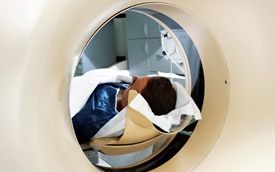Publication
Article
Oncology Live®
Novel PET Strategy May Predict Utility of Clinical Options
Author(s):
The desire to reduce the risk and severity of treatment-related toxicity by rapidly discontinuing ineffective therapy, and the increasing use of highly sensitive imaging technology.

This commentary addresses the intersection of several important, yet quite complex, cancer treatment variables. These include the selection of optimal therapy for individual patients within an increasing number of antineoplastic drug options in many conditions, the desire to reduce the risk and severity of treatment-related toxicity by rapidly discontinuing ineffective therapy, and the increasing use of highly sensitive imaging technology.
One central question is the potential utility of a novel strategy to define relatively quickly the effectiveness of treatment and to optimize the overall value (consideration of benefits, side effects, and costs) associated with a particular therapeutic regimen.
With important exceptions, the standard approach to evaluating the utility of systemic antineoplastic therapy is to administer several cycles of therapy, and then perform imaging or other diagnostic testing procedures (eg, serum tumor markers, bone marrow examination).
The benefit of this approach is that during an extended period of time—a minimum of several weeks to as long as several months—it is possible to gain a clear picture of the potential for a specific strategy to achieve a meaningful biologic (eg, shrinkage of tumor masses, major decline in serum tumor marker) and/or clinical endpoint (eg, decrease in pain).
Unfortunately, this evaluation strategy frequently means that a number of cycles of what is subsequently demonstrated to be ineffective therapy will be administered before this outcome is revealed, with its associated unnecessary side effects and often substantial costs.
In addition, there may be considerable delay in employing an alternative management approach, which may ultimately be considered a far more effective strategy in the control of the disease process in this individual patient. Further, if excessive toxicity is experienced during these initial treatment cycles with an ineffective regimen, a prolonged delay in examining alternative approaches may very negatively impact the patient’s clinical outcome.
Is it possible that the potential for a particular therapeutic regimen to exert a favorable influence on the course of the malignancy can be clearly defined at a much earlier point in time following the initiation of a treatment program than the time required to observe changes in a conventional radiographic imaging study, such as a computed tomography or magnetic resonance imaging scan?

Maurie Markman, MD
Editor-in-Chief of OncLive
Senior vice president for Clinical Affairs and National Director for Medical Oncology Cancer Treatment Centers of America, Eastern Regional Medical Center
Two recent papers in the oncology literature provide a provocative hint at a promising future for such evaluations, examining the issue in the setting of the use of erlotinib in the management of non-small cell lung cancer.1,2
In the first study, 34 previously untreated patients with stage IV disease underwent positron emission tomography (PET) at baseline and at 1 and 6 weeks after initiation of treatment with this agent.1 Employing FDG (2’-deoxy-2’-[18F]fluoro-D-glucose), the investigators found that patients who experienced a prospectively defined metabolic response (compared with their baseline determination) at the 1-week evaluation exhibited a statistically significant improvement in both progression-free and overall survival compared with the nonresponding (metabolic response) patient population.
In the second study, a total of 74 patients underwent PET imaging at baseline, and 14 and 56 days after their first dose of erlotinib.2 Conventional radiographic imaging studies were also performed. Similar to the conclusions noted in the previously discussed report, the study determined that, compared with the baseline FDG study, patients whose evaluation at 14 days revealed a prospectively defined PET response experienced a statistically significant (P = 0.03) improvement in both progression-free and overall survival compared with individuals failing to achieve a response.
If the findings of these 2 studies can be confirmed by other investigative groups and in larger sample sizes, the results suggest the clinical benefit associated with the delivery of this important antineoplastic agent may be defined quite early after initiation of a very short test phase.
Further, these provocative data also suggest it may be realistic to use this novel imaging strategy to determine relatively rapidly the biological impact of other systemic antineoplastic approaches in individual tumors.
Finally, although subsequent trials will be required for confirmation, it is reasonable to speculate that this early evidence of biological activity could be translated into genuine clinical benefit (eg, decrease in cancer-related symptoms, and improvement in progression-free, symptom-free, and overall survival), could permit the timely discontinuation of ineffective agents, and may enhance the overall cost-effectiveness associated with systemic antineoplastic therapy.
References
- Zander T, Scheffler M, Nogova L, et al. Early prediction of nonprogression in advanced non-small cell lung cancer treated with erlotinib by using [(18)F]fl uorodeoxyglucose and [(18) F]fl uorothymidine positron emission tomography. J Clin Oncol. 2011; 29(13):1701-1708.
- Mileshkin L, Hicks RJ, Hughes BG, et al. Changes in 18F-fluorodeoxyglucose and 18F-fluorodeoxythymidine positron emission tomography imaging in patients with non-small cell lung cancer treated with erlotinib. Clin Cancer Res. 2011; 17(10):3304-3315.









